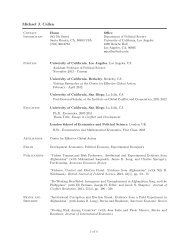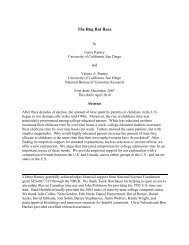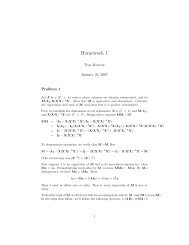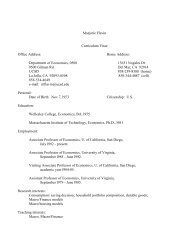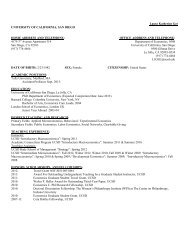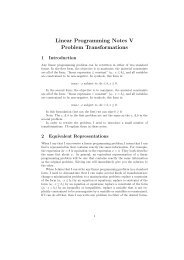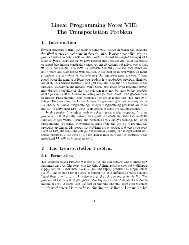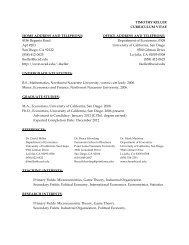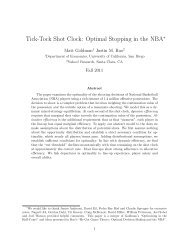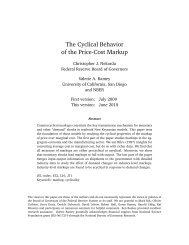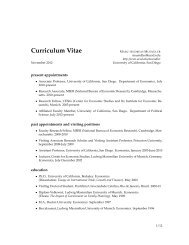Endogenous derivation of 'money' - UC San Diego Department of ...
Endogenous derivation of 'money' - UC San Diego Department of ...
Endogenous derivation of 'money' - UC San Diego Department of ...
You also want an ePaper? Increase the reach of your titles
YUMPU automatically turns print PDFs into web optimized ePapers that Google loves.
462 R. M. Starr<br />
[m, n]’s endowment, r [m,n]<br />
m , is specified as part <strong>of</strong> the description <strong>of</strong> the subpopulation.<br />
Households formulate their trading plans deciding how much <strong>of</strong> each good to<br />
trade at each pairwise trading post. This leads to the rather messy notation:<br />
b [m,n]{i,j}<br />
ℓ<br />
= planned purchase <strong>of</strong> good ℓ by household [m, n]<br />
at trading post {i, j}<br />
s [m,n]{i,j}<br />
ℓ = planned sale <strong>of</strong> good ℓ by household [m, n] at trading post{i, j}<br />
The bid prices (the prices at which the trading post will buy from households) at<br />
{i, j} are q {i,j}<br />
i ,q {i,j}<br />
j for goods i and j respectively. The price <strong>of</strong> i is in units <strong>of</strong> j.<br />
The price <strong>of</strong> j is in units <strong>of</strong> i. The ask price (the price at which the trading post will<br />
sell to households) <strong>of</strong> j is the inverse <strong>of</strong> the bid price <strong>of</strong> i (and vice versa). That<br />
<br />
is, q {i,j}<br />
−1 <br />
i and q {i,j}<br />
−1 j are the ask prices <strong>of</strong> j and i at {i, j}. The trading<br />
post {i, j} covers its costs by the difference between the bid and ask prices <strong>of</strong> i<br />
<br />
and j, that is, by the spread q {i,j}<br />
−1 j −q {i,j}<br />
<br />
i and the spread q {i,j}<br />
−1 i −q {i,j}<br />
j .<br />
Transaction costs at the trading post are incurred in good 0. Post {i, j} pays for 0<br />
in i and j, acquired in trade through the difference in bid and ask prices. The bid<br />
price <strong>of</strong> 0 in terms <strong>of</strong> i is q {i,j}<br />
(i)0 . The bid price <strong>of</strong> 0 in terms <strong>of</strong> j is q{i,j}<br />
(j)0 .<br />
Given q {i,j}<br />
i ,q {i,j}<br />
j , for all {i, j} household h then forms its buying and selling<br />
plans, in particular deciding which trading posts to use to execute his desired trades.<br />
Household hɛH faces the following constraints on its transaction plans:<br />
(T.i) b h{i,j}<br />
n<br />
(T.ii) b h{i,j}<br />
i<br />
> 0, only if n = i, j; s h{i,j}<br />
n<br />
≤ q {i,j}<br />
j<br />
· s h{i,j}<br />
j<br />
,b h{i,j}<br />
j<br />
> 0, only if n = i, j, 0.<br />
≤ q {i,j}<br />
i<br />
· s h{i,j}<br />
i<br />
for each {i, j}.<br />
There is a slightly distinct version <strong>of</strong> (T.ii), (T.ii ′ ), applying to households in H 0 .<br />
s h{i,j}<br />
(j)0<br />
(T.ii ′ )ForhɛH 0 , decompose s h{i,j}<br />
0<br />
and b h{i,j}<br />
j<br />
, so that s h{i,j}<br />
(i)0<br />
≤ q {i,j}<br />
(j)0<br />
+sh{i,j}<br />
(j)0<br />
· sh{i,j}<br />
(j)0<br />
into nonnegative elements s h{i,j}<br />
(i)0<br />
= sh{i,j} 0 , then we have b h{i,j}<br />
i<br />
for each {i, j}.<br />
(T.iii) x h n = r h n + Σ {i,j}b h{i,j}<br />
n<br />
− Σ {i,j}s h{i,j}<br />
n<br />
≤ q {i,j}<br />
(i)0<br />
≥ 0, 0 ≤ n ≤ N.<br />
and<br />
· sh{i,j}<br />
(i)0<br />
Note that condition (T.ii) [and (T.ii’)] defines a budget balance requirement at<br />
the transaction level, implying the decentralized character <strong>of</strong> trade. Since the budget<br />
constraint applies to each pairwise transaction separately, there may be a demand<br />
for a carrier <strong>of</strong> value to move purchasing power between distinct transactions. h<br />
,q {i,j}<br />
, and chooses s h{i,j}<br />
,n= i, j<br />
faces the array <strong>of</strong> bid prices q {i,j}<br />
i<br />
j<br />
n<br />
and b h{i,j}<br />
n<br />
(and n =0for hɛH 0 ), to maximize u h (x h ) subject to (T.i), (T.ii), (T.iii). That is,<br />
h chooses which pairwise markets to transact in and a transaction plan to optimize<br />
utility, subject to a multiplicity <strong>of</strong> pairwise budget constraints.<br />
The trading posts in Sections 3 and 4 have linear transaction technologies. A<br />
competitive equilibrium is an appropriate solution concept resulting in zero pr<strong>of</strong>its<br />
,




